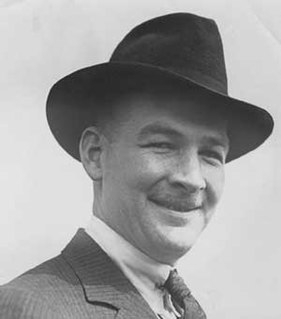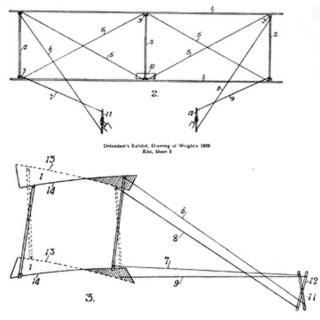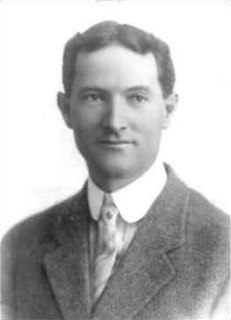
Orville Wright and Wilbur Wright, together known as the Wright brothers, were American aviation pioneers generally credited with inventing, building, and flying the world's first successful motor-operated airplane. They made the first controlled, sustained flight of a powered, heavier-than-air aircraft with the Wright Flyer on December 17, 1903, 4 mi (6 km) south of Kitty Hawk, North Carolina, at what is now known as Kill Devil Hills. The brothers were also the first to invent aircraft controls that made fixed-wing powered flight possible.

An aileron is a hinged flight control surface usually forming part of the trailing edge of each wing of a fixed-wing aircraft. Ailerons are used in pairs to control the aircraft in roll, which normally results in a change in flight path due to the tilting of the lift vector. Movement around this axis is called 'rolling' or 'banking'.

Waldo Dean Waterman was an inventor and aviation pioneer from San Diego, California. He developed a series of tailless swept-wing aircraft incorporating tricycle landing gear, culminating in a low-cost and simple-to-fly flying car.

Wing warping was an early system for lateral (roll) control of a fixed-wing aircraft. The technique, used and patented by the Wright brothers, consisted of a system of pulleys and cables to twist the trailing edges of the wings in opposite directions. In many respects, this approach is similar to that used to trim the performance of a paper airplane by curling the paper at the back of its wings.

An aircraft stabilizer is an aerodynamic surface, typically including one or more movable control surfaces, that provides longitudinal (pitch) and/or directional (yaw) stability and control. A stabilizer can feature a fixed or adjustable structure on which any movable control surfaces are hinged, or it can itself be a fully movable surface such as a stabilator. Depending on the context, "stabilizer" may sometimes describe only the front part of the overall surface.

Charles Francis Walsh was an American pioneer aviator who died in a crash in Trenton, New Jersey.

Louis Ferdinand Ferber was a French Army officer who played an important role in the development of aviation during the early 1900s. Although his aircraft experiments were belatedly successful, his early recognition and publicizing of the work of the Wright Brothers was a major influence on the development of aviation in Europe.

Frank Edward Boland, James Paul Boland and Joseph John Boland were early aircraft designers from Rahway, New Jersey who started the Boland Airplane and Motor Company.

A tailless aircraft has no other horizontal aerodynamic surface besides its main wing. It may still have a fuselage, vertical tail fin and/or vertical rudder.

The Curtiss No. 2, often known as the Reims Racer, was a racing aircraft built in the United States by Glenn Curtiss in 1909 to contest the Gordon Bennett Cup air race in Reims, France that year.

The Santos-Dumont Demoiselle was a series of aircraft built in France by world aviation pioneer Alberto Santos-Dumont. They were light-weight monoplanes with a wire-braced wing mounted above an open-framework fuselage built from bamboo. The pilot's seat was below the wing and between the main wheels of the undercarriage. The rear end of the boom carried a tailwheel and a cruciform tail. The name is a synonym for "jeune fille"—young girl or woman—but also the common name in French for a Damselfly.

The Handley Page Type D or H.P.4 was a single-seat, single-engined tractor monoplane, the first Handley Page design to fly for more than a few hops. Only one was built.

The pioneer era of aviation was the period of aviation history between the first successful powered flight, generally accepted to have been made by the Wright Brothers on 17 December 1903, and the outbreak of the First World War in August 1914.

The Greene 1909 Biplane was an American pioneering aircraft.

William Greene was an early aviation pioneer who was one of the first American pilots and airplane constructor. He developed a passion for flying at an early age and was an active member and treasurer of the Aeronautical Society of New York. In 1909 he designed, constructed and piloted a biplane at the Morris Park Raceway, Bronx, NY. He later formed an aircraft manufacturing company in Rochester, NY

The Boland V-8 was an aircraft engine that was developed by the Boland Brothers for use in their tailless aircraft. Between 1908 and 1914, four versions of this motor were produced ranging in power from 60 hp (45 kW) to 125 hp (93 kW). The Boland motors all used an unusual concentric overhead valve. This arrangement positioned the intake valve in the middle of the exhaust valve. These were actuated by a single push rod and rocker arm.

In early 1910, Dr. William Greene designed, built and sold the successor to his own 1909 biplane in Mineola, Long Island at the Aeronautic Society's facility. This aircraft was a fairly conventional biplane in the Farman style. By mid April 1910, Greene had left New York City and moved to Rochester, NY to start a company to produce aircraft of his own design.

The Boland 1911 Conventional Biplane was an American pioneering aircraft.

The Boland 1912 Tailless Biplane was a refinement of the Boland 1911 Tailless Biplane. The major change in the 1912 biplane is the addition of a central nacelle that contained the pilot, passenger and the engine.

The Boland 1914 Monoplane Flying Boat was a tailless, pusher flying boat built by the Boland Aeroplane and Motor Company






















